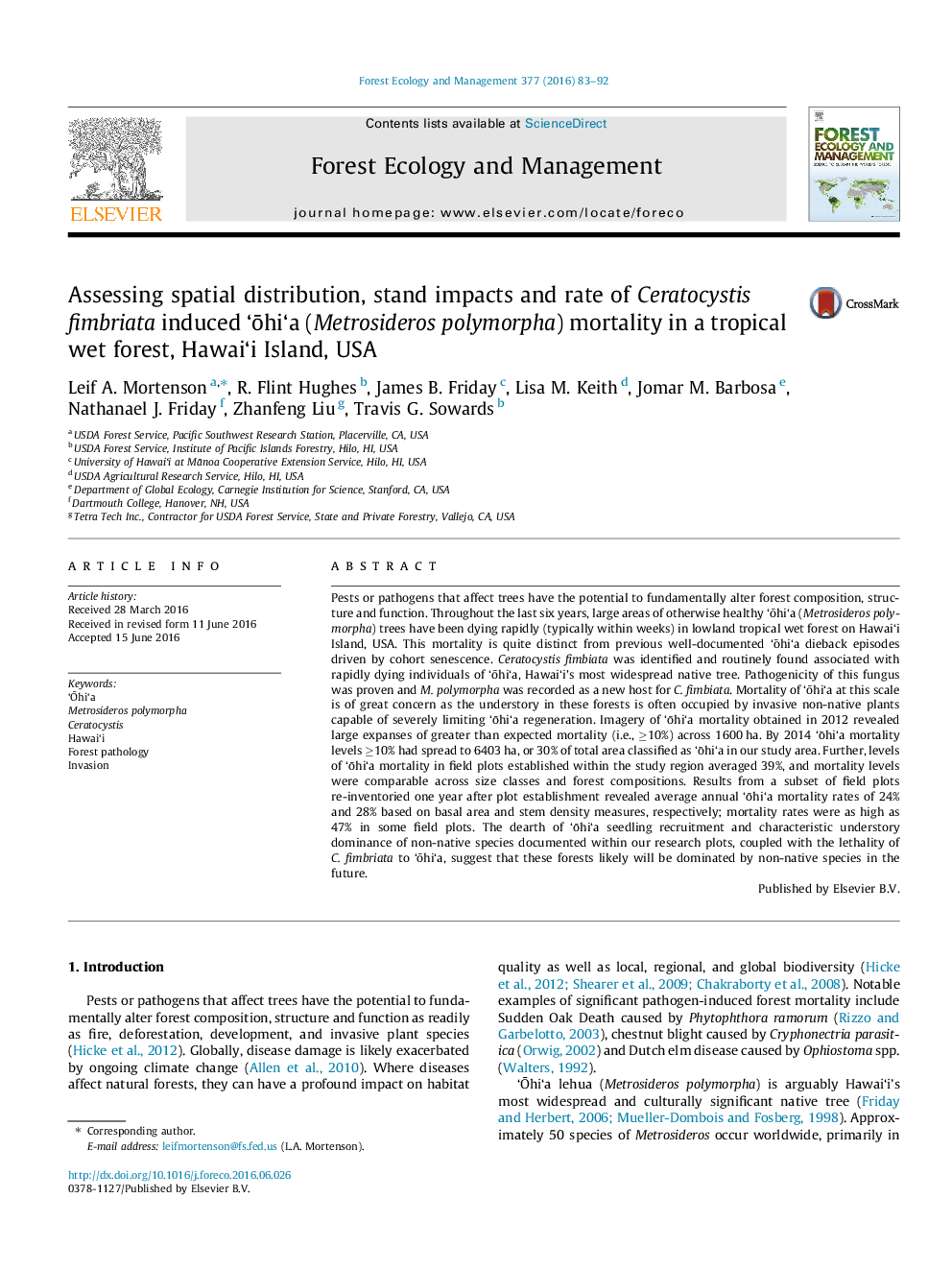| کد مقاله | کد نشریه | سال انتشار | مقاله انگلیسی | نسخه تمام متن |
|---|---|---|---|---|
| 6542070 | 159146 | 2016 | 10 صفحه PDF | دانلود رایگان |
عنوان انگلیسی مقاله ISI
Assessing spatial distribution, stand impacts and rate of Ceratocystis fimbriata induced 'Åhi'a (Metrosideros polymorpha) mortality in a tropical wet forest, Hawai'i Island, USA
دانلود مقاله + سفارش ترجمه
دانلود مقاله ISI انگلیسی
رایگان برای ایرانیان
کلمات کلیدی
موضوعات مرتبط
علوم زیستی و بیوفناوری
علوم کشاورزی و بیولوژیک
بوم شناسی، تکامل، رفتار و سامانه شناسی
پیش نمایش صفحه اول مقاله

چکیده انگلیسی
Pests or pathogens that affect trees have the potential to fundamentally alter forest composition, structure and function. Throughout the last six years, large areas of otherwise healthy 'Åhi'a (Metrosideros polymorpha) trees have been dying rapidly (typically within weeks) in lowland tropical wet forest on Hawai'i Island, USA. This mortality is quite distinct from previous well-documented 'Åhi'a dieback episodes driven by cohort senescence. Ceratocystis fimbiata was identified and routinely found associated with rapidly dying individuals of 'Åhi'a, Hawai'i's most widespread native tree. Pathogenicity of this fungus was proven and M. polymorpha was recorded as a new host for C. fimbiata. Mortality of 'Åhi'a at this scale is of great concern as the understory in these forests is often occupied by invasive non-native plants capable of severely limiting 'Åhi'a regeneration. Imagery of 'Åhi'a mortality obtained in 2012 revealed large expanses of greater than expected mortality (i.e., â¥10%) across 1600 ha. By 2014 'Åhi'a mortality levels â¥10% had spread to 6403 ha, or 30% of total area classified as 'Åhi'a in our study area. Further, levels of 'Åhi'a mortality in field plots established within the study region averaged 39%, and mortality levels were comparable across size classes and forest compositions. Results from a subset of field plots re-inventoried one year after plot establishment revealed average annual 'Åhi'a mortality rates of 24% and 28% based on basal area and stem density measures, respectively; mortality rates were as high as 47% in some field plots. The dearth of 'Åhi'a seedling recruitment and characteristic understory dominance of non-native species documented within our research plots, coupled with the lethality of C. fimbriata to 'Åhi'a, suggest that these forests likely will be dominated by non-native species in the future.
ناشر
Database: Elsevier - ScienceDirect (ساینس دایرکت)
Journal: Forest Ecology and Management - Volume 377, 1 October 2016, Pages 83-92
Journal: Forest Ecology and Management - Volume 377, 1 October 2016, Pages 83-92
نویسندگان
Leif A. Mortenson, R. Flint Hughes, James B. Friday, Lisa M. Keith, Jomar M. Barbosa, Nathanael J. Friday, Zhanfeng Liu, Travis G. Sowards,